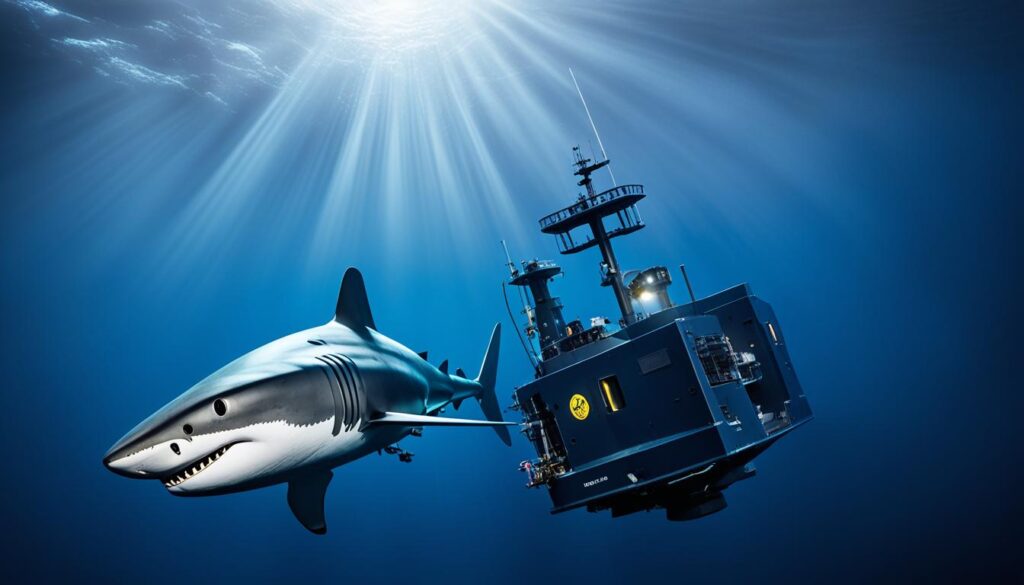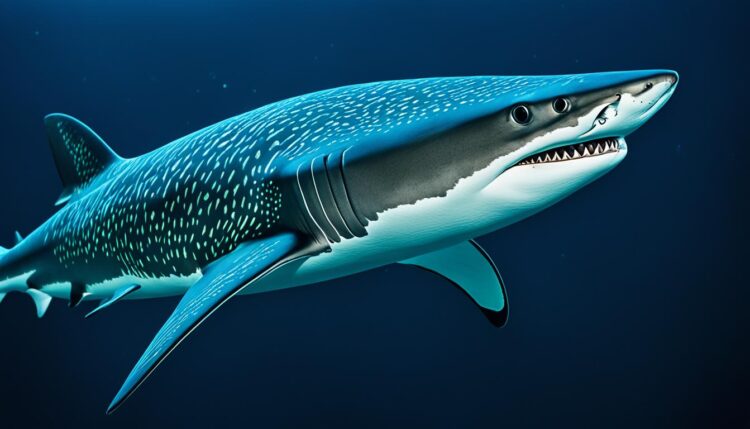Deep-sea sharks represent some of the most enigmatic creatures within the world’s oceans, particularly in regions like the Southern Indian Ocean, which has remained largely uncharted. These mysterious inhabitants of our oceanic ecosystems embody ocean mysteries and evoke a profound sense of curiosity among marine scientists.
The quest to understand these elusive entities notably propels explorations and research in marine life, unveiling aspects of deep-sea shark species that continue to astonish even seasoned oceanographers. As we delve into the depths of these underwater realms, the richness and diversity of deep-sea sharks paint a picture of the intricate balances within oceanic ecosystems.
Key Takeaways
- Deep-sea sharks are some of the most enigmatic creatures in the ocean.
- The Southern Indian Ocean remains largely uncharted, housing unique marine life.
- Understanding deep-sea sharks advances marine science and ocean exploration.
- Deep-sea shark species play a crucial role in maintaining oceanic ecosystems.
- Ongoing research continues to reveal new aspects of these fascinating creatures.
Introduction to Deep-Sea Sharks
Deep-sea sharks, extraordinary members of the elasmobranch family, have intrigued scientists for decades. Their solitary existence in the ocean’s most dimly lit regions makes them compelling subjects for ocean research.
“The allure of deep-sea predators lies in their enigmatic behavior and adaptation to one of the planet’s harshest environments.”
These magnificent creatures are vital to marine conservation efforts. Deep-sea sharks serve as critical indicators for the health of ocean ecosystems. Understanding their behaviors, life cycles, and interactions is essential for comprehensive marine conservation strategies.
The study of deep-sea predators has gained momentum, leading to significant advancements in ocean research. Missions aimed at exploring the elusive nature of these sharks often uncover remarkable ecological insights, contributing to a broader understanding of marine life.
Through continuous ocean research and dedicated marine conservation initiatives, scientists hope to unlock further mysteries surrounding deep-sea elasmobranchs. These efforts are crucial, as they not only help in preserving the intricate balance of oceanic ecosystems but also in promoting sustainable practices for future generations.
The Habitat of Deep-Sea Sharks
The habitat of deep-sea sharks is as intriguing as the creatures themselves. These resilient predators flourish in some of the most extreme environments on Earth, displaying remarkable adaptability and evolutionary prowess.
Southern Indian Ocean Ecosystems
The Southern Indian Ocean is a vital component of deep-sea ecosystems. This region, abundant with steeply sloped seamounts, provides essential habitats for various deep-sea shark species. Seamount ecosystems, known for their biodiversity hotspots, support complex life cycles crucial for the survival of these sharks. The rich biological diversity found here underscores the Southern Indian Ocean’s significance.
Hydrothermal Vents and Cold Seeps
Hydrothermal vents and cold seeps are fascinating phenomena within deep-sea ecosystems. These underwater environments create chemosynthetic oases that are pivotal to the deep ocean food web. Hydrothermal vents, featuring high concentrations of minerals and unique temperatures, host various microorganisms forming the base of a complex food chain. Meanwhile, cold seeps also serve as essential habitats where deep-sea sharks thrive, fostering diverse marine life reliant on these unique conditions. Collectively, hydrothermal vents and cold seeps highlight the adaptability and resilience of deep-sea sharks.
| Feature | Southern Indian Ocean | Hydrothermal Vents | Cold Seeps |
|---|---|---|---|
| Ecosystem Role | Supports diverse marine life | Mineral-rich environments | Chemosynthetic food webs |
| Significance | Biodiversity hotspots | Base of deep-sea food chains | Unique habitats for specialized species |
Unique Adaptations of Deep-Sea Sharks
Deep-sea sharks possess remarkable biological adaptations that facilitate their survival in the extreme conditions of the abyssal plains and trenches. Their adaptive traits have evolved to address the unique challenges they face, such as limited light, scarcity of food, and immense pressure. These adaptations, crucial for deep-ocean survival, help these incredible creatures thrive in some of the most inhospitable habitats on Earth.
Low Fecundity and Slow Reproduction
One of the most notable characteristics of deep-sea sharks is their low fecundity and slow reproduction rates. Unlike their shallow-water counterparts, these sharks produce fewer offspring and have longer gestation periods. This strategy, although it results in fewer young, ensures that each individual is well-developed and capable of surviving in the harsh deep-ocean environment. These reproductive adaptations are essential for maintaining stable populations and highlight the importance of targeted shark conservation efforts.
Survival Strategies in Extreme Environments
Deep-sea sharks exhibit several survival strategies that enable them to endure extreme pressures, low temperatures, and limited food sources. Their biological adaptations include specialized metabolisms that allow them to survive on minimal food intake for extended periods. Additionally, they have adapted to sense their prey in near-total darkness using highly sensitive electroreceptors. These adaptations are fundamental to their deep-ocean survival and underscore their evolutionary success in overcoming the environmental challenges of the deep sea.
| Biological Adaptations | Deep-Ocean Survival | Reproduction Rates | Shark Conservation |
|---|---|---|---|
| Specialized metabolisms | Surviving on minimal food | Low fecundity | Targeted efforts needed |
| Electroreceptors | Sensing prey in darkness | Slow reproduction | Population stability |
| Extended gestation periods | Resilience to extreme pressures | Fewer offspring | Long-term species survival |
Deep-Sea Sharks as Keystone Predators
Deep-sea sharks are often regarded as apex predators in their respective habitats. These extraordinary creatures play a crucial role in sustaining marine ecosystem balance. By preying on a variety of species, they help regulate community composition and maintain the health of oceanic environments.
One of the main functions of deep-sea sharks in the marine world is food web regulation. By targeting weaker or overabundant species, these sharks ensure that no single species overruns the habitat. This predatory influence prevents the depletion of resources and supports biodiversity within their ecosystems.
“Deep-sea sharks are vital for preserving the intricacies and stability of marine food webs,” says marine biologist Dr. Sylvia Earle. “Their role as keystone predators cannot be overstated.”
The top-down control exerted by these apex predators is indispensable for the functioning of marine ecosystems. Without them, the balance would tilt, resulting in negative cascading effects that disrupt various marine habitats. Maintaining the population and health of deep-sea sharks is, therefore, imperative for achieving a balanced marine ecosystem.
| Role | Impact on Ecosystem | Examples |
|---|---|---|
| Apex Predators | Regulate populations, prevent overpopulation of certain species | Deep-sea shark preying on squid and octopus |
| Marine Ecosystem Balance | Maintain ecological harmony, support biodiversity | Shark predation preventing one species’ dominance |
| Food Web Regulation | Stabilize food chains, ensure diversity of prey species | Linking primary producers to top consumers |
Impact of Commercial Fishing on Deep-Sea Sharks
The encroachment of commercial fishing into the remote and pristine habitats of deep-sea sharks is raising alarm bells among marine conservationists. The use of unsustainable fishing practices in these areas poses a severe threat to shark populations already stressed by their naturally slow reproduction rates. Commercial fleets target various species, inadvertently leading to shark population decline through bycatch and habitat destruction.
Particularly concerning is the expansion of fisheries into the Southern Indian Ocean. This region, rich in biodiversity, is witnessing significant impacts. The lack of stringent fisheries management exacerbates the issue, as regulations struggle to keep pace with the rapid growth of deep-sea fishing operations. Effective management is crucial to preserving the delicate balance of seamount ecosystems and ensuring long-term sustainability.
To understand the implications better, it is essential to examine the dynamics between commercial fishing and deep-sea shark populations. The following table provides an insightful comparison regarding the impact of unsustainable fishing practices on key shark species.
| Shark Species | Population Status | Primary Threats | Conservation Measures |
|---|---|---|---|
| Bluntnose Sixgill Shark | Vulnerable | Bycatch, Habitat Destruction | Sustainable Fishing Practices |
| Greenland Shark | Near Threatened | Overfishing, Climate Change | Protected Areas, Quotas |
| Goblin Shark | Least Concern | Bycatch, Marine Pollution | Enhanced Fisheries Management |
Maintaining an equilibrium requires collaborative efforts between governments, conservation groups, and the fishing industry. Strengthening fisheries management and promoting sustainable harvesting methods are pivotal steps to mitigate the adverse effects of commercial fishing on deep-sea shark populations. Proactive measures will help conserve these fascinating creatures and the ecosystems they support.
Recent Discoveries and Expeditions
Recent marine expeditions have provided an unprecedented glimpse into the mysterious world of deep-sea sharks. These exhaustive scientific explorations have unveiled new species discoveries, contributing significantly to the field of oceanic research. Below are key expeditions that have enriched our understanding of marine ecosystems.
Melville Ridge Expeditions
The Melville Ridge expeditions have made remarkable strides in scientific exploration, systematically cataloging deep-sea sharks and other marine life forms previously unknown to science. These marine expeditions have brought forward extensive data, documenting various new species discoveries. The impact of this oceanic research is further amplified by the collection of samples that are pivotal for ongoing studies in marine biology.

90 East Ridge Promises
The ventures to the 90 East Ridge have opened thrilling prospects in oceanic research. This previously unexplored region holds promising potential for new species discovery and groundbreaking scientific exploration. Marine expeditions here have already yielded significant finds, which continue to shape our understanding of marine biodiversity. The continuous study of this region is expected to offer more invaluable insights into the hidden depths of our oceans.
Biodiversity Hotspots in the Southern Indian Ocean
The Southern Indian Ocean is home to some of the most vibrant marine biodiversity hotspots. Seamount habitats within this region are recognized for their unique ecosystems, often harboring a rich array of undiscovered marine life. These underwater mountains create isolated environments that sustain various species, particularly noteworthy are the deep-sea sharks that dwell in these depths.
Seamount Ecosystems
Seamount habitats are known to be biodiversity hotspots due to their complex structures and resources. These habitats provide ideal conditions for numerous marine species, resulting in diverse and thriving ecosystems. Marine biologists have only begun to scratch the surface of understanding the extent of life forms in these regions, making them crucial to marine biodiversity studies. These seamount ecosystems stand out because of several factors:
- Complex structure providing niches for various species
- Isolation promoting unique evolutionary paths
- Rich nutrient upwelling supporting abundant marine life
Unknown Species
One of the most fascinating aspects of studying seamount habitats is the discovery of unknown species. Marine scientists have uncovered numerous new species, underlining how much of the ocean remains unexplored. These findings significantly enhance our understanding of marine biodiversity. The continuous revelation of these previously unknown species underscores the wealth of undiscovered marine life residing in these underwater mountains.
| Seamount Ecosystem Characteristics | Impact on Marine Biodiversity |
|---|---|
| Complex terrains | Creates numerous niches and habitats |
| Isolation | Leads to unique evolutionary paths |
| Nutrient upwelling | Supports diverse marine life |
Deep-Sea Exploration and Marine Biology
Deep-sea exploration plays a crucial role in advancing marine biology. With the advent of deep-sea technological advances, previously inaccessible marine habitats have become reachable for comprehensive study. These technologies include remotely operated vehicles (ROVs) and submersibles that allow scientists to delve into the mysteries of the ocean’s depths.
Moreover, oceanographic studies enable researchers to understand the complex ecosystems where deep-sea sharks and other marine species thrive. These studies are pivotal in unveiling the interactions that govern marine habitats and the biodiversity that sustains them. The integration of new technologies in these studies ensures that data collection is more accurate and comprehensive, fostering a better understanding of deep-sea environments.
Here’s an overview of essential technologies driving these advancements:
| Technology | Function | Applications |
|---|---|---|
| Remotely Operated Vehicles (ROVs) | Unmanned submersibles controlled from the surface | Inspecting deep-sea habitats, collecting samples, capturing images |
| Autonomous Underwater Vehicles (AUVs) | Independent, programmable underwater devices | Surveying vast areas, mapping ocean floors, measuring environmental parameters |
| High-Resolution Sonar | Advanced acoustic technology for ocean mapping | Creating detailed maps of underwater terrains, detecting habitats |
| Deep-Sea Sampling Tools | Various instruments for collecting biological and geological samples | Examining marine biodiversity, studying geological formations |
Conclusion
The exploration of deep-sea sharks provides a striking lens through which we can understand the broader issue of ocean conservation and science. These elusive creatures inhabit some of the most extreme environments on our planet, demonstrating the deep-sea research importance in unraveling the mysteries that lie beneath the waves. From the unique adaptations that allow them to survive in such inhospitable conditions to their role as keystone predators, deep-sea sharks are vital to the health of marine ecosystems.
However, they face significant conservation challenges. The impact of commercial fishing, habitat destruction, and climate change all threaten their survival. The Melville Ridge Expeditions and discoveries on the 90 East Ridge underscore the importance of concerted efforts in research and conservation to safeguard these remarkable species and their habitats. Addressing these conservation challenges requires global collaboration and innovative strategies, pivotal in shaping the future of oceanography.
As we continue to delve deeper into the unknown, the future of oceanography holds tremendous potential for new discoveries. The biodiversity hotspots in the Southern Indian Ocean and the uncharted species found in seamount ecosystems highlight the need for sustained exploration. Each expedition reveals more about the intricate balance of marine life, underscoring the deep-sea research importance. Our growing understanding of these underwater worlds not only enhances scientific knowledge but also strengthens efforts to conserve the vast, enigmatic depths of our oceans.











